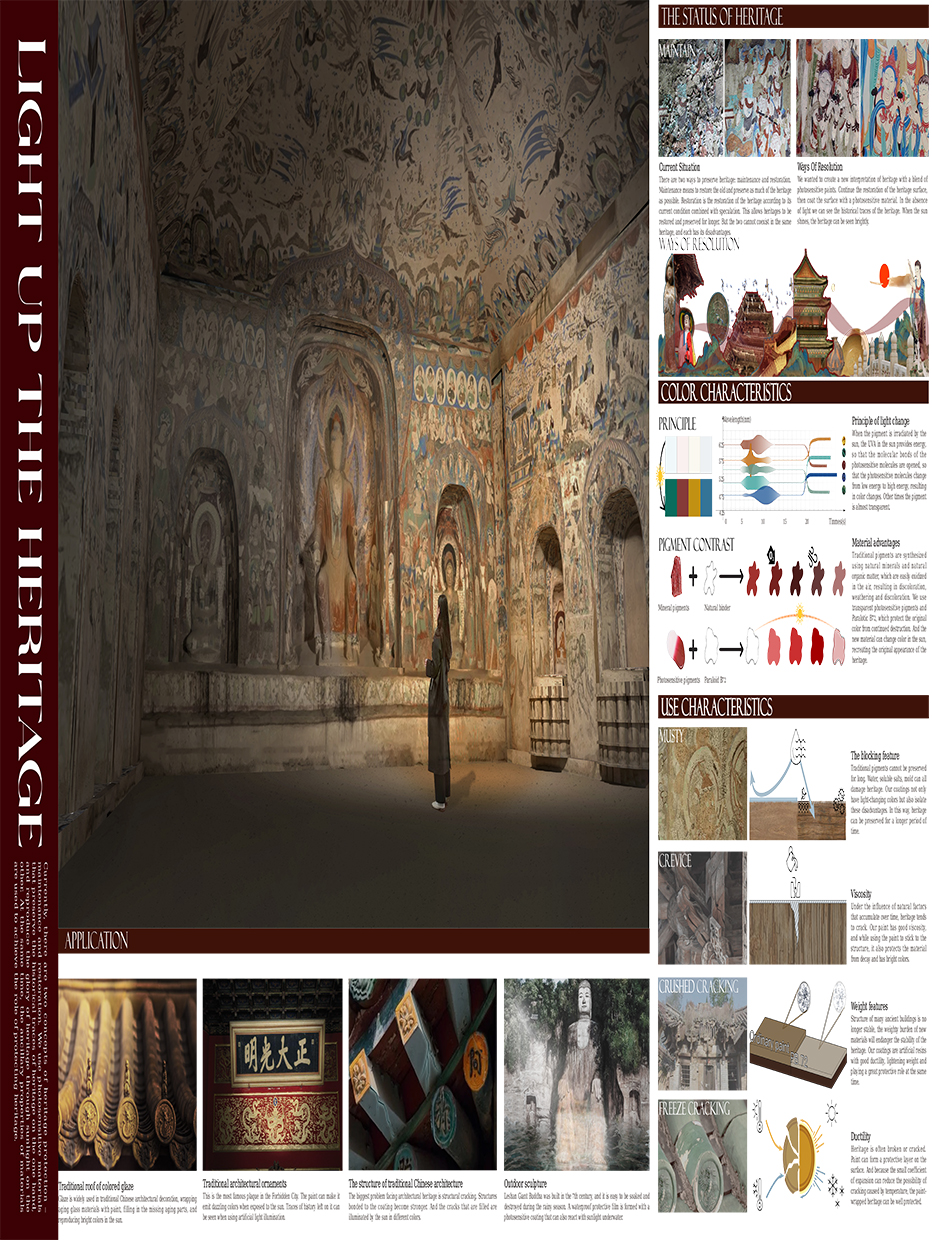Light Up The Heritage

Category
Daylight investigations - Region 4: Asia and Oceania
Students
Wang Qiuting
Zhong Qing
Jia Sihao
Li Jiaxuan
Guo Yiyang
School
Tianjin University
Country
China
Download
Download ↓
Currently, there are two concepts of heritage protection – maintenance and restoration. We use photosensitive materials that preserve the historical traces of heritage on the one hand, and reproduce the glory of heritage through sunlight on the other. At the same time, the ancillary properties of materials are used to achieve the role of protecting heritage.There are two ways to preserve heritage: maintenance and restoration. Maintenance means to restore the old and preserve as much of the heritage as possible. Restoration is the restoration of the heritage according to its current condition combined with speculation. This allows heritages to be restored and preserved for longer. But the two cannot coexist in the same heritage, and each has its disadvantages.We wanted to create a new interpretation of heritage with a blend of photosensitive paints. Continue the restoration of the heritage surface, then coat the surface with a photosensitive material. In the absence of light we can see the historical traces of the heritage. When the sun shines, the heritage can be seen brightly.When the pigment is irradiated by the sun, the UVA in the sun provides energy, so that the molecular bonds of the photosensitive molecules are opened, so that the photosensitive molecules change from low energy to high energy, resulting in color changes. Other times the pigment is almost transparent.Traditional pigments are synthesized using natural minerals and natural organic matter, which are easily oxidized in the air, resulting in discoloration, weathering and discoloration. We use transparent photosensitive pigments and Paralotic B72, which protect the original color from continued destruction. And the new material can change color in the sun, recreating the original appearance of the heritage.Traditional pigments cannot be preserved for long. Water, soluble salts, mold can all damage heritage. Our coatings not only have light-changing colors but also isolate these disadvantages. In this way, heritage can be preserved for a longer period of time.Under the influence of natural factors that accumulate over time, heritage tends to crack. Our paint has good viscosity, and while using the paint to stick to the structure, it also protects the material from decay and has bright colors.Structure of many ancient buildings is no longer stable, the weighty burden of new materials will endanger the stability of the heritage. Our coatings are artificial resins with good ductility, lightening weight and playing a great protective role at the same time.Heritage is often broken or cracked.Paint can form a protective layer on the surface. And because the small coefficient of expansion can reduce the possibility of cracking caused by temperature, the paint-wrapped heritage can be well protected.1.Traditional roof of colored glaze:Glaze is widely used in traditional Chinese architectural decoration, wrapping aging glass materials with paint, filling in the missing aging parts, and reproducing bright colors in the sun.2.Traditional architectural ornaments:This is the most famous plaque in the Forbidden City. The paint can make it emit dazzling colors when exposed to the sun. Traces of history left on it can be seen when using artificial light illumination.3. The structure of traditional Chinese architecture:The biggest problem facing architectural heritage is structural cracking. Structures bonded to the coating become stronger. And the cracks that are filled are illuminated by the sun in different colors.4.Outdoor sculpture:Leshan Giant Buddha was built in the 7th century, and it is easy to be soaked and destroyed during the rainy season. A waterproof protective film is formed with a photosensitive coating that can also react with sunlight underwater.Currently, there are two concepts of heritage protection – maintenance and restoration. We use photosensitive materials that preserve the historical traces of heritage on the one hand, and reproduce the glory of heritage through sunlight on the other. At the same time, the ancillary properties of materials are used to achieve the role of protecting heritage.There are two ways to preserve heritage: maintenance and restoration. Maintenance means to restore the old and preserve as much of the heritage as possible. Restoration is the restoration of the heritage according to its current condition combined with speculation. This allows heritages to be restored and preserved for longer. But the two cannot coexist in the same heritage, and each has its disadvantages.We wanted to create a new interpretation of heritage with a blend of photosensitive paints. Continue the restoration of the heritage surface, then coat the surface with a photosensitive material. In the absence of light we can see the historical traces of the heritage. When the sun shines, the heritage can be seen brightly.

































